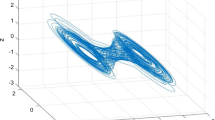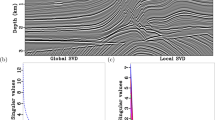Abstract
In this paper, a modified-rate-quantization algorithm for multiple input multiple output (MIMO) systems is proposed using singular-value decomposition (SVD). This low complexity scheme adapts the subchannel transmit power and spectral efficiency in the spatial and temporal domains under transmit power and instantaneous bit error rate (BER) constraints. It is shown that with five discrete-rate levels, the proposed scheme reaches a spectral efficiency performance similar to the scheme with a continuous rate. The robustness of the proposed scheme to channel state information (CSI) imperfections is also studied. The obtained results show that the spectral efficiency is unaffected up to a certain level, but the bit error rate (BER) performance is particularly sensitive to these imperfections, especially at high SNR levels. Indeed, this ideally designed MIMO system over-estimates the subchannels, which leads to a deterioration of the BER performance. A new version of this algorithm, which is suitable for vertical Bell Labs layered space–time (V-BLAST) systems, is also presented. Through simulation results, it appears that the extended algorithm allows to reach a better performance in terms of spectral efficiency than other known schemes, but it is more sensitive to imperfect CSI than the first version.
Similar content being viewed by others
References
Catreux S., Gesbert D., Heath R.W. (2002). Adaptive modulation and MIMO coding for broadband wireless data networks. IEEE Communications Magazine 40: 108–115
Zhuang A.J.H., Dai L., Zhou S., Yao Y. (2003). Low complexity per-antenna rate and power control approach for closed-loop V-BLAST. IEEE Transactions on Communications 51: 1783–1787
Chung, S., Howard, H. C., & Lozano, A. (2001). Low complexity algorithm for rate and power quantization in extended V-BLAST. In Proceedings of the vehicular technology conference, Vol. 2, Atlantic city, NJ, pp. 910–914, Oct. 2001.
Goldsmith A. (2002). EE359 wireless communications. Stanford University Press, Stanford, CA
Seong, K., & Kim, T. (2002). Adaptive modulation for MIMO systems in time-varying channels. EE359 course project.
Chatterjee S., Fernando W.A.C., Wasantha M.K. (2003). Adaptive modulation based MC-CDMA systems for 4G wireless consumer applications. IEEE Transactions on Consumer Electronics 49(4): 995–1003
Chatterjee S., Fernando W.A.C. (2004). Blind estimation of channel and modulation scheme in adaptive modulation schemes for OFDM-CDMA based 4G systems. IEEE Transactions on Consumer Electronocs 50(4): 1065–1075
Ghanem, K., & Denidni, A. T. (2005). New variable-rate variable-power adaptive modulation scheme for time-varying MIMO channels. 2005 IEEE AP-S international symposium on antennas and propagation and USNC/URSI, Vol. 2A, pp. 325–328 , Jul. 2005.
Goldsmith A.J., Chua S. (1997). Variable-rate variable-power MQAM for fading channels. IEEE Transactions on Communications 45: 1218–1230
Foschini G.J., Gans M.J. (1998). On limits of wireless communications in a fading environment when using multiple antennas. Wireless Personal Communications 6: 315–335
Telatar I.E. (1999). Capacity of multi-antenna Gaussian channels. European Transactions on Telecommunication 10: 585–595
Catreux S., Driessen P.F., Greenstein L.J. (2002). Data throughputs using multiple-input multiple-output (MIMO) techniques in a noise-limited cellular environment. IEEE Transactions on Wireless Communications 1: 226–235
Chung, S., Howard, H. C., & Lozano, A. (2001). Approaching eigenmode BLAST channel capacity using V-BLAST with rate and power feedback. In Proceedings of the IEEE vehicular technology conference. (VTC’2001 Fall), Vol. 2, Atlantic City, NJ, pp. 915–919, Oct. 2001.
Foschini G.J. (1996). Layered space–time architecture for wireless communication in a fading environment when using multielement antennas. Labs Technical Journal 1(2): 41–59
Wolniansky, P. W., Foschini, G. J., Golden, G. D., & Valenzuela, R. A. (1998). V-BLAST: an architecture for achieving very high data rates over the rich-scattering wireless channel. In Proceedings of the international symposium on signals, systems, electronics (ISSSE-98), Pisa, Italy, pp. 295–300, Oct. 1998.
Varanasi, M. K., & Guess, T. (1998). Optimum decision feedback multiuser equalization with sucessive decoding achieves the total capacity of the Gaussian multiple-access channel. Asilomar conference, pp. 1405–1409, 1998.
Ghanem, K., & Denidni, A. T. (2005). Approaching ergodic capacity in time varying MIMO V-Blast channels. Canadian conference on electrical and computer engineering, Vol. 10, May. 2005.
Zhou Z., Vucetic B. (2004). Design of adaptive modulation using imperfect CSI in MIMO systems. IEE Letters 40(17): 1073–1075
Shengli Z., Giannakis G.B. (2004). Adaptive modulation for multiantenna transmissions with channel mean feedback. IEEE Transactions on Wireless Communications 3(5): 1626–1636
Shengli Z., Giannakis G.B. (2004). How accurate channel prediction needs to be for transmit-beamforming with adaptive modulation over Rayleigh MIMO channels. IEEE Transactions on Wireless Communications 3(4): 1285–1294
Zhou Z., Vucetic B., Dohler M., Yonghui L. (2005). Mimo systems with adaptive modulation. IEEE Transactions on Vehicular Technology 54(5): 1828–1842
Simon M.K., Hinedi S.M., Lindsey W.C. (1995). Digital communication techniques. Prentice Hall, New Jersey
Heath, R. W., & Paulraj, A. J. (2001). Antenna selection for spatial multiplexing system based on minimum error rate. In Proceedings of the international conference on communications, Helsinki, Finland, pp. 2276–2280, June 2001.
Gore D.A., Heath R.W., Paulraj A.J. (2002). Transmit selection in spatial multiplexing systems. IEEE Communications Letters 6: 491–493
Author information
Authors and Affiliations
Corresponding author
Rights and permissions
About this article
Cite this article
Ghanem, K., Denidni, T.A. & Ghanem, F. Modified-rate-quantization algorithm for multiple-input multiple-output systems under imperfect channel knowledge. Wireless Pers Commun 43, 1241–1255 (2007). https://doi.org/10.1007/s11277-007-9298-8
Received:
Accepted:
Published:
Issue Date:
DOI: https://doi.org/10.1007/s11277-007-9298-8




